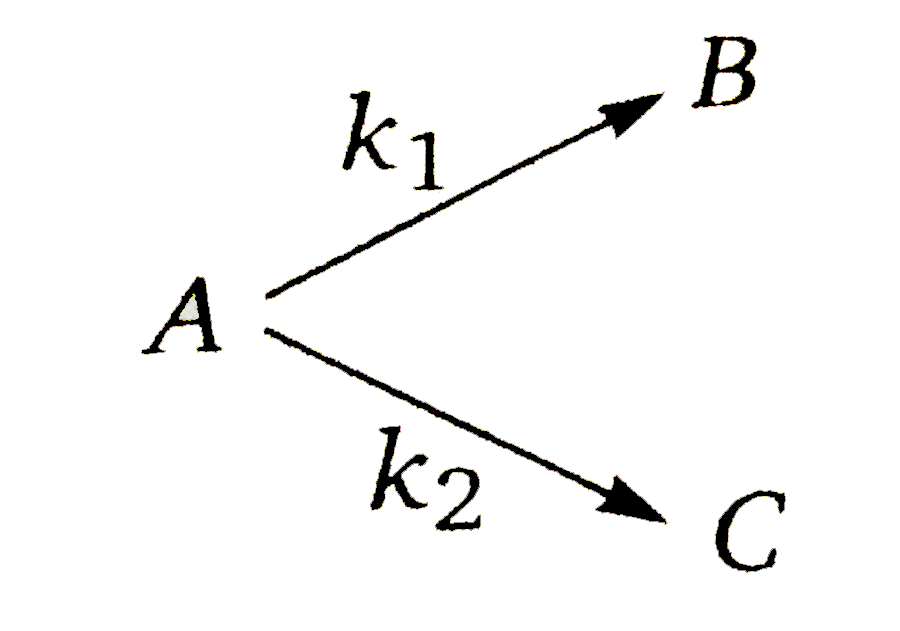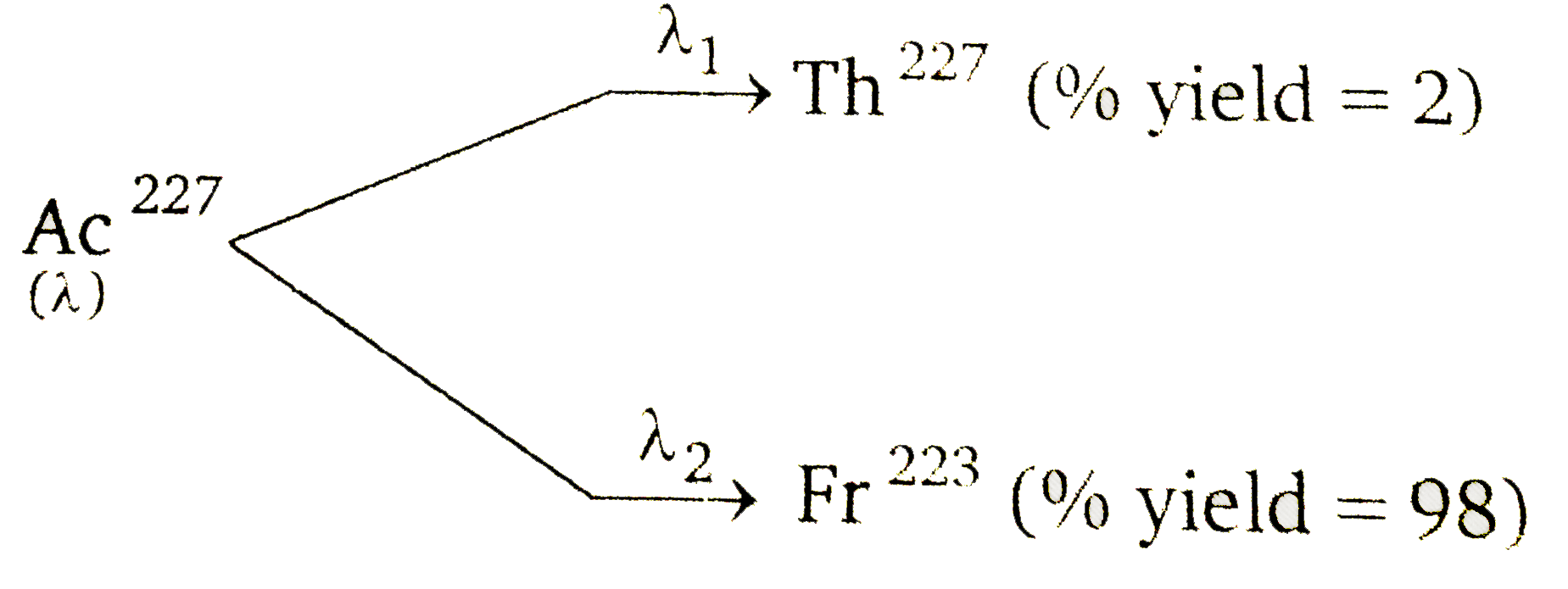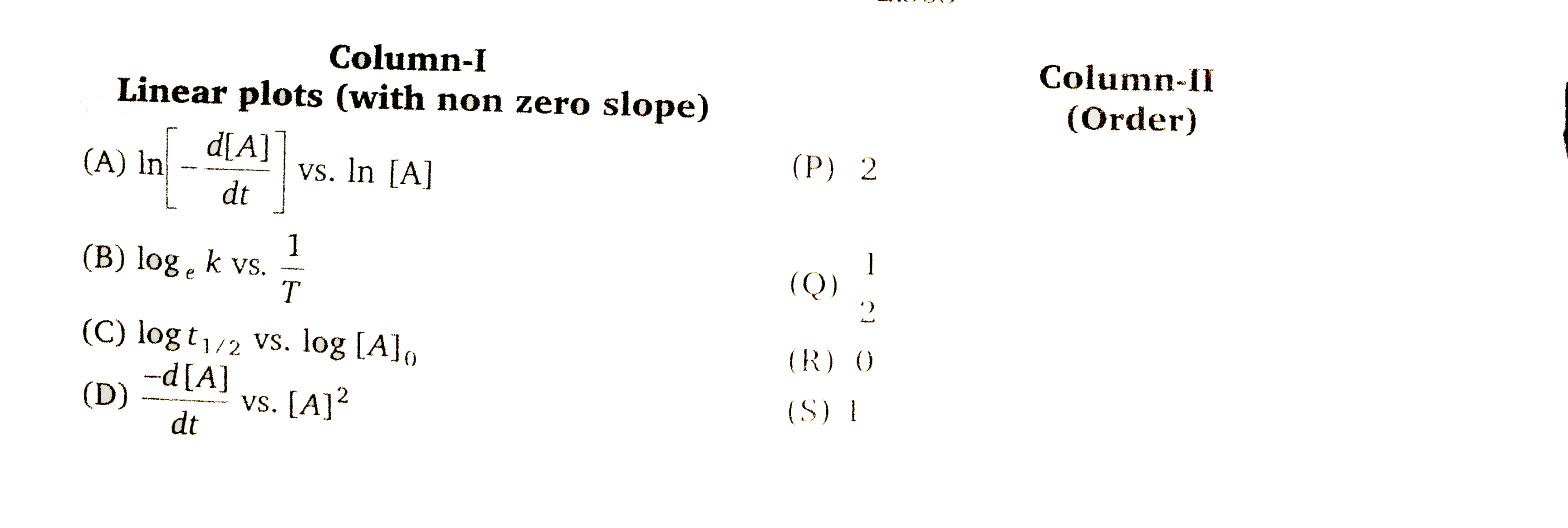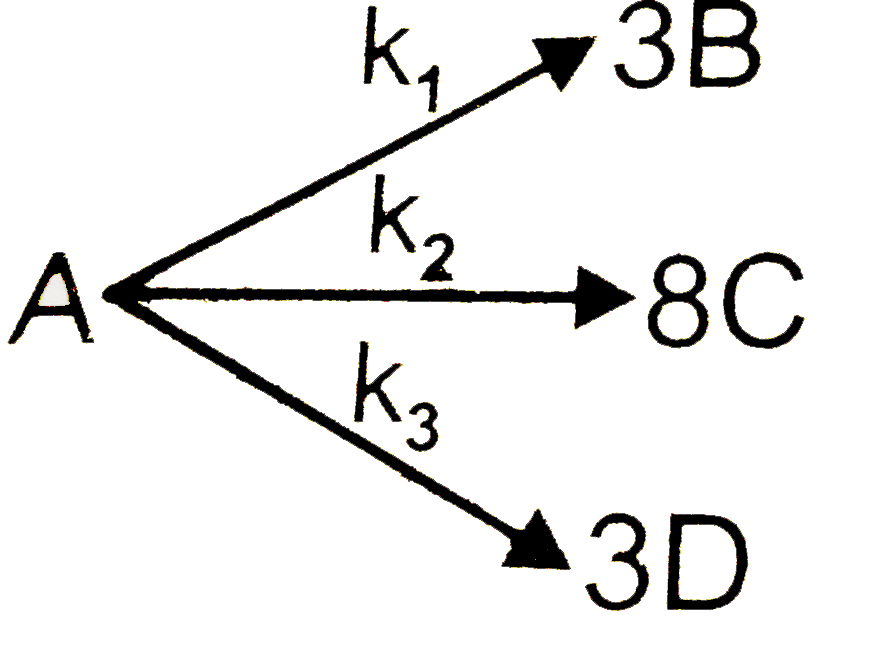Level 3 - Assertion - Reason Type Questions from NARENDRA AWASTHI CHEMICAL KINETIC & NUCLEAR CHEMISTRY for Class 12
| Class 12 | CHEMISTRY |
| Chapter | CHEMICAL KINETIC & NUCLEAR CHEMISTRY |
| NARENDRA AWASTHI | Level 3 - Assertion - Reason Type Questions |
| Medium | English |
| Academic Year | 2023-2024 |
Question 22
For the reactionA→B, for which graph between half life (t1/2)and∈itialconcentration(a)oftherectantisgivenbelow<br><imga≤ocr_imageload∈g=lazysrc=https://d10lpgp6xz60nq.cloudfront.net/physics_images/NRA_PHY_CHM_JMA_C07_E01_022_Q01.pngwh=80%mx-autosty≤=background:white;><br>Hencegraphbetween-(d[A])/(dt) and time will be: View SolutionQuestion 30
The following data pertain to reaction between A and B
S.No[A][B]RatemolL−1molL−1molL−1sec−1I1×10−22×10−22×10−4II2×10−22×10−24×10−4III2×10−24×10−28×10−4
Which of the following interference(s) can be drawn from the above data
(a) Rate constatnt of the reaction 10−4
(b) Rate law of reaction is k[A][B]
(c ) Rate of reaction increases four times on doubling the concentration of both the reactant Select the correct answer codesView SolutionQuestion 56
The decomposition of N2O in carbon tetrachloride was followed bymesuring the volume of O2 gas evolved : 2N2O5(CCL4)→2N2O4(CCL4)+O2(g) . The maximum volume of O2 gas obtained was 100 cm3. In 500 minutes, 90 cm of O2 were evolved. The first order rate constant (in −1min for the dissaperance of N2O is :View SolutionQuestion 60
The decomposition of azo methane, at certain temperature acccording to the equation (CH3)2N2→C2H6+N2 is a first order reaction.
After 40 minutes from the start, the total pressure developed is found to be 350 mm Hg in place of initial pressure 200 mm Hg of azo methane. The value of rate constant k is :View SolutionQuestion 64
A→B first order reaction A is ooptical active and B is optically inactive. A series of experiment were conducted on a solution of A
Time060min∞optical rotation82∘77∘2∘
assume some imurity is present calculate the otical rotation for 5 hours.)
(Given in 1.066=0.064, e0.16=1.17)View SolutionQuestion 160
A(aq)→B(aq)+C(aq) is first order reaction.
Time t ∞
moles of reagent n1 n2
Reaction prgress is measured with the help of titration of reagent 'R'. If all A, B and C react with reagent and have 'n' factors [n factor,eq. mass=mol.massn in the ratio of 1:2:3 with the reagent, the k in terms of t, n1 and n2 is :View SolutionQuestion 161
The gaseous decomposition reaction, A(g)→2B(g)+C(g) is observed to first order over the excess of liquid water at 25∘C. It is found that after 10 minutes the total pressure of system is 188 torr and after very long time it is 388 torr. The rate constant of the reaction (in hr^(−1)) is : [Given : vapour pressure of H2O at 25∘ is 28 torr (ln2=0.7, ln3=1.1,ln10=2.3)]View SolutionQuestion 162
The reaction ,SucroseH+−−→ Glucose + Fructose, take place at certain temperature while the volume of solution is maintained at 1 litre. At time zero the initial rotation of the mixture is 34∘. After 30 minutes the total rotation of solutions is 19∘ and after a very long time, the total roation is −11∘C Find the time when solution was potically inaactive.View SolutionQuestion 163
A gaseous compound A reacts by three independent first order process (as shown in figure) with rate constant 2×10−3,3×10−3 and 1.93×10−3sec−1 for products B, C and D respectively, If initially pure A was taken in a closed container with p=8 atm then the partial pressure of B (in atm) after 100 sec from starting the experiment.
 View Solution
View SolutionQuestion 164
A compound A dissociates by two parallel first order paths at certain temperature
A(g)k1(−1min)−−−−−−→2B(g) k1=6.93×10−3−1min
A(g)k1(−1min)−−−−−−→C(g) k2=6.93×10−3−1min
The reaction is started with 1 mole of pure 'A' litre closed container with initial pressure 2 atm. What is the pressure (in atm) developed in container after 50 minutes from start of experiment?View SolutionQuestion 166
The reaction cis-Xkf<kb⇒ trans-X is first order in both direction At 25∘C, the equilibrium constant is 0.10 and the rate constant kf=3×10−4s−1 In an experiment starting with the pure cis- from , how long would it take for half of the equilibrium amount of the trans-iomer to be fromed?View SolutionQuestion 168
Consider the reaction.

The rate constant for two parallel reactions were found to be 10−2dm−2mol−1s−1 and 4×10−2dm−3mol−1s−1 . If the corresponding energies of activation of the parallel reaction are 100 and 120 kJ/mol respectively, what is the net energy of activation (Ea) of A View SolutionQuestion 169
A reaction takes place in various steps. The rate constatn for first, second, third and fifth steps are k1,k2,k3 and k5 respectively The overall rate constant is given by
k=k2k3(k1k5)1/2
If activation energy are 40, 60, 50, and 10 kJ/mol respectively, the overall energy of activation (kJ/mol) is : View SolutionQuestion 171
For first order parallel reactions k1 and k2 are 4and 2min(−1) respectively at 300 K. If the activation energies for the formation of B and C are respectively 30,000 and 38,314 joule/ mol respectively, the temperature at which B and C will be obtained in equimolar ratio is :
 View Solution
View SolutionQuestion 176
Upon irradiating californium with neutrons, a scientist discovered a new nuclide having mass number of 250 and a half-life of 30 min. After 90 min. of irradiation, the observed radioactivity due to nuclied was 100 dis/min. How many atoms of the nucliede were prepared intially? View SolutionQuestion 180
A fresh radioactive mixture contians short lived sppecies A and B. Both emitting α-particles intially of 8000 α particles per minute. 20 minutes later, they emis at the rate of 3500 α -particles per minute. If the half-lives of the species A and B are 10 minutes and 500 hours respectively, then the ratio of activities of A: B the intial mixture was: View SolutionQuestion 181
In order to determine the volume of blood in an animal, a 1.0mL sample of solution of 103 dpm of .31H is injected into the animal blood stream. After sufficient time for circulatory equilibrium to be established, 2mL of blood is found to have activity to 10 dpm. The volume of blood in animal is : View SolutionQuestion 183
Find the age of an ancient Egyptian wooden article (in years) from the given information.
(i) Activity of 1g of carbon obtained from ancient wooden article =7 counts/min/g
(ii) Activity of 1 g carbon obtained from fresh wooden sample =15.4 counts per min/g
(iii) Precentage increases in level of C14 due to nuclear explosions in past 100 years is 10%
(iv) t1/2 of .146C=5770 years View SolutionQuestion 189
Arrhenius studies the effect of temperature on the rate of a reaction and postulted that rate constant varies with temperature exponentially as k=Ae−Ea/RT . Thuis method is generally used for finding the activation energy of a reaction. Keeping temperature constant, the effect of catalyst on the activation energy has also been studied.
The pre-exponetial factor in the Arrhenius equation of a first order reaction has the unit : View SolutionQuestion 190
Arrhenius studies the effect of temperature on the rate of a reaction and postulted that rate constant varies with temperature exponentially as k=Ae−Ea/RT . Thuis method is generally used for finding the activation energy of a reaction. Keeping temperature constant, the effect of catalyst on the activation energy has also been studied.
If x is the fraction of molecules having energy greater than Ea it will be given by : View SolutionQuestion 191
Arrhenius studies the effect of temperature on the rate of a reaction and postulted that rate constant varies with temperature exponentially as k=Ae−Ea/RT . Thuis method is generally used for finding the activation energy of a reaction. Keeping temperature constant, the effect of catalyst on the activation energy has also been studied.
If the rate of reaction doubles for 10∘C rise of temperature form 290K to 300K, the activation energy of the reaction will be approximately : View SolutionQuestion 192
An important parameter of a photochemical reaction is the quantum effeiciency or quantum yield (ϕ) which is defined as
ϕ=moles of the substance reactionmoles of photons absorbed
Absorption of UV radiation decompose acetone according to the reaction
(CH3)2COhv−−→C2H6+CO
The quantum yield of a reaction at λ=330nm is 0.4 . A sample of acetone absorbs monochromatic radiation at λ330mn at the rate of 7.2×10−3Js−1 (given : NA=6×1023,h=6.6×10−34 in S.I unit). The rate of formation of CO(mol/s) is : View SolutionQuestion 193
An important parameter of a photochemical reaction is the quantum effeiciency or quantum yield (ϕ) which is defined as
ϕ=moles of the substance reactionmoles of photons absorbed
Absorption of UV radiation decompose acetone according to the reaction
(CH3)2COhv−−→C2H6+CO
If quantum yield in 0.8 then rate of formation of C2H6(mol/s) is : View SolutionQuestion 194
Radioactive disintegration is a first order reaction and it's rate depends only upon the nature of nucleus and does not depend upon external factors like temperature and pressure . The rate of radioactive disintegration (Activity) is represented as −dNdt=λN , Where λ = decay constant , N number of nuclei at time t , N0 = initial no. of nuclei.
The above equation after integration can be represented as λ=2.303tlog(N0N)
Half-life period of U232 is 2.5×105 years . In how much time will the amount of U237 remaining be only 25% of the original amount ? View SolutionQuestion 195
Radioactive disintegration is a first order reaction and it's rate depends only upon the nature of nucleus and does not depend upon external factors like temperature and pressure . The rate of radioactive disintegration (Activity) is represented as −dNdt=λN , Where λ = decay constant , N number of nuclei at time t , N0 = initial no. of nuclei.
The above equation after integration can be represented as λ=2.303tlog(N0N)
Calculate the half-life period of a radioactive element which remains only 1/16 of it's original amount in 4740 years : View SolutionQuestion 196
Radioactive disintegration is a first order reaction and it's rate depends only upon the nature of nucleus and does not depend upon external factors like temperature and pressure . The rate of radioactive disintegration (Activity) is represented as −dNdt=λN , Where λ = decay constant , N number of nuclei at time t , N0 = initial no. of nuclei.
The above equation after integration can be represented as λ=2.303tlog(N0N)
What is the activity in Ci (curie) of 1.0 mole of Plutonium - 239 ? (t1/2=24,000 years) View SolutionQuestion 223
Each question contains STATEMENTS-1 (Assertion) and STATEMENT -2 (Reason).
Examine the statements carefully and mark the correct answer according to the instructions given below:
STATEMENT-1:Molecurity has no meaning for a complex reactions
STATEMENT-2:Molecurity defined only for RDSView SolutionQuestion 224
Each question contains STATEMENTS-1 (Assertion) and STATEMENT -2 (Reason).
Examine the statements carefully and mark the correct answer according to the instructions given below:
STATEMENT-1: An elementry reaction cannot have fractional order.
STATEMETNT-2:Stoichiometric coefficients in an elementary reaction can be fractional.View SolutionQuestion 225
Each question contains STATEMENTS-1 (Assertion) and STATEMENT -2 (Reason).
Examine the statements carefully and mark the correct answer according to the instructions given below:
STATEMENT-1:Concentration of reactant in zero order reaction is constant.
STATEMENT-2: For zero order reaction A→B, successive half life of reaction decrease with the progress of the reaction.View SolutionQuestion 226
Each question contains STATEMENTS-1 (Assertion) and STATEMENT -2 (Reason).
Examine the statements carefully and mark the correct answer according to the instructions given below:
STATEMENTS-1: Acid catalysed hydrolysis of esters is pseudo first order reaction.
STATEMETNT-2:Water is present in excess in given reaction.View SolutionQuestion 227
Each question contains STATEMENTS-1 (Assertion) and STATEMENT -2 (Reason).
Examine the statements carefully and mark the correct answer according to the instructions given below:
STATEMENT-1: The order of reaction can have fractional value.
STATEMENT-2: For an elementary reaction, the parial orders are determined by the reaction stoichiometryView SolutionQuestion 228
Each question contains STATEMENTS-1 (Assertion) and STATEMENT -2 (Reason).
Examine the statements carefully and mark the correct answer according to the instructions given below:
STATEMENT-1: Catalyst may increase the rate constant to a large extent.
STATEMENT-2:By using suitable catalyst, we can significantly increase yield.View SolutionQuestion 229
Each question contains STATEMENTS-1 (Assertion) and STATEMENT -2 (Reason).
Examine the statements carefully and mark the correct answer according to the instructions given below:
STATEMENT-1: For each 10∘C rise of temperature the k is nearly double.
STATEMENT -2: Energy wise distribution of molecules in a gas sample is an exponential function of temperature so e−Ea/RT is doubled.View SolutionQuestion 230
Each question contains STATEMENTS-1 (Assertion) and STATEMENT -2 (Reason).
Examine the statements carefully and mark the correct answer according to the instructions given below:
STATEMENT-1: Product is formed only when the required orientation and energy conditions are met.
STATEMENT-2: All collisions between reactants yield the desired productView SolutionQuestion 232
Each question contains STATEMENTS-1 (Assertion) and STATEMENT -2 (Reason).
Examine the statements carefully and mark the correct answer according to the instructions given below:
STATEMENT-1: For exothermic reaction equilibrium constant decrease with increase in temperature.
STATEMETN-2: For exothermic reaction rate constant decrease with decrease in temperature.View SolutionQuestion 233
Each question contains STATEMENTS-1 (Assertion) and STATEMENT -2 (Reason).
Examine the statements carefully and mark the correct answer according to the instructions given below:
STATEMENT -1: If the activation energy of reaction is zero, temperature will have no effect on the rate constant.
STATEMENT-2: Lower the activation energy faster is the raction. View SolutionQuestion 234
Each question contains STATEMENTS-1 (Assertion) and STATEMENT -2 (Reason).
Examine the statements carefully and mark the correct answer according to the instructions given below:
STATEMENT-1: Active complex is an intermediate product.
STATEMENT-2: Active complex is unstable with high vibrational energy.View SolutionQuestion 235
Each question contains STATEMENTS-1 (Assertion) and STATEMENT -2 (Reason).
Examine the statements carefully and mark the correct answer according to the instructions given below:
STATEMENT-1: The pre-exponential factor A has the same units for all reactions.
STATEMENT -2: e−Ea/RT has no unit. View SolutionQuestion 236
Each question contains STATEMENTS-1 (Assertion) and STATEMENT -2 (Reason).
Examine the statements carefully and mark the correct answer according to the instructions given below:
STATEMENT -1: γ−rays have very high penetrating power.
STATEMENT-2: γ-rays are electromagnetic raidations of high energy.View SolutionQuestion 237
Each question contains STATEMENTS-1 (Assertion) and STATEMENT -2 (Reason).
Examine the statements carefully and mark the correct answer according to the instructions given below:
STATEMENT-1: Nuclide .3013Al is less stable than .4020Ca.
STATEMENT-2: Nuclide having odd number of protons and neutrons are generally unstable.View SolutionQuestion 238
Each question contains STATEMENTS-1 (Assertion) and STATEMENT -2 (Reason).
Examine the statements carefully and mark the correct answer according to the instructions given below:
STATEMENT-1: Disintegration of .31H (tritium) is accompanied by β−emission.
STATEMENT-2: Tritium has high n/p ratio.View SolutionQuestion 239
Each question contains STATEMENTS-1 (Assertion) and STATEMENT -2 (Reason).
Examine the statements carefully and mark the correct answer according to the instructions given below:
STATEMENT-1: The life of radiactive object (organic origin) can found with the help of carbon dating.
STATEMENT-2: .146C is a α and β-emitter. View SolutionQuestion 240
Each question contains STATEMENTS-1 (Assertion) and STATEMENT -2 (Reason).
Examine the statements carefully and mark the correct answer according to the instructions given below:
STATEMENT-1: Neutron are the best bombarding particles.
STATEMENT-2: Neutrons are neutral particles.View SolutionQuestion 241
Each question contains STATEMENTS-1 (Assertion) and STATEMENT -2 (Reason).
Examine the statements carefully and mark the correct answer according to the instructions given below:
STATEMENT-1: Nucleus does not contain fee electrons, yet it emit beta-particles
STATEMENT-2: At high n/p ratio, one neutron supposed to give 1 proton and 1 e−(β).View SolutionQuestion 242
Each question contains STATEMENTS-1 (Assertion) and STATEMENT -2 (Reason).
Examine the statements carefully and mark the correct answer according to the instructions given below:
STATEMENT-1: Rate of disintegration of thorium increases with the increase in moles of thorium.
STATEMENT-2: Rate of disintegration does not depend upon temperature, pressureView SolutionQuestion 246
Carbon monoxide reacts with O2 to form CO2: 2CO(g)+O2(g)→2CO2(g)
Infromations about this reaction are given in the table below.
[CO]mol/L[O2]mol/LRate of reaction (mol/L.min)0.020.024×10−50.040.021.6×10−40.020.048×10−5
What is the value for the rate constant for the reaction in properly related unit? View SolutionQuestion 248
For an acid catalysed reaction AH+−−→B half life period is independent of concentration of A at given pH. At same concentrationn of A half tiem is 10 min at pH=2 and half life time is 100 min at PH=3. If the rate law expression of reaction is r=K[A]x[H+]y then calculate (x+y)View Solution
All Exercises from NARENDRA AWASTHI Class 12 CHEMISTRY CHEMICAL KINETIC & NUCLEAR CHEMISTRY
- EXERCISE
- LEVEL 1 (Q.123 TO Q.150)
- LEVEL 1 (Q.3 TO Q.32)
- LEVEL 1 (Q.33 TO Q.62)
- LEVEL 1 (Q.63 TO Q.92)
- LEVEL 1 (Q.93 TO Q.122)
- LEVEL 2
- LEVEL 2 (Q.3 TO Q.32)
- LEVEL 2 (Q.33 TO Q.35)
- LEVEL 3 - ASSERTION - REASON TYPE QUESTIONS
- LEVEL 3 - ONE OR MORE ANSWERS ARE CORRECT
- LEVEL 3 - PASSAGE
- LEVEL 3 - SUBJECTIVE PROBLEMS
- EXERCISE
- LEVEL 1 (Q.123 TO Q.150)
- LEVEL 1 (Q.3 TO Q.32)
- LEVEL 1 (Q.33 TO Q.62)
- LEVEL 1 (Q.63 TO Q.92)
- LEVEL 1 (Q.93 TO Q.122)
- LEVEL 2
- LEVEL 2 (Q.3 TO Q.32)
- LEVEL 2 (Q.33 TO Q.35)
- LEVEL 3 - ASSERTION - REASON TYPE QUESTIONS
- LEVEL 3 - ONE OR MORE ANSWERS ARE CORRECT
- LEVEL 3 - PASSAGE
- LEVEL 3 - SUBJECTIVE PROBLEMS
- EXERCISE
- LEVEL 1 (Q.123 TO Q.150)
- LEVEL 1 (Q.3 TO Q.32)
- LEVEL 1 (Q.33 TO Q.62)
- LEVEL 1 (Q.63 TO Q.92)
- LEVEL 1 (Q.93 TO Q.122)
- LEVEL 2
- LEVEL 2 (Q.3 TO Q.32)
- LEVEL 2 (Q.33 TO Q.35)
- LEVEL 3 - ASSERTION - REASON TYPE QUESTIONS
- LEVEL 3 - ONE OR MORE ANSWERS ARE CORRECT
- LEVEL 3 - PASSAGE
- LEVEL 3 - SUBJECTIVE PROBLEMS
- EXERCISE
- LEVEL 1 (Q.123 TO Q.150)
- LEVEL 1 (Q.3 TO Q.32)
- LEVEL 1 (Q.33 TO Q.62)
- LEVEL 1 (Q.63 TO Q.92)
- LEVEL 1 (Q.93 TO Q.122)
- LEVEL 2
- LEVEL 2 (Q.3 TO Q.32)
- LEVEL 2 (Q.33 TO Q.35)
- LEVEL 3 - ASSERTION - REASON TYPE QUESTIONS
- LEVEL 3 - ONE OR MORE ANSWERS ARE CORRECT
- LEVEL 3 - PASSAGE
- LEVEL 3 - SUBJECTIVE PROBLEMS
- EXERCISE
- LEVEL 1 (Q.123 TO Q.150)
- LEVEL 1 (Q.3 TO Q.32)
- LEVEL 1 (Q.33 TO Q.62)
- LEVEL 1 (Q.63 TO Q.92)
- LEVEL 1 (Q.93 TO Q.122)
- LEVEL 2
- LEVEL 2 (Q.3 TO Q.32)
- LEVEL 2 (Q.33 TO Q.35)
- LEVEL 3 - ASSERTION - REASON TYPE QUESTIONS
- LEVEL 3 - ONE OR MORE ANSWERS ARE CORRECT
- LEVEL 3 - PASSAGE
- LEVEL 3 - SUBJECTIVE PROBLEMS
- EXERCISE
- LEVEL 1 (Q.123 TO Q.150)
- LEVEL 1 (Q.3 TO Q.32)
- LEVEL 1 (Q.33 TO Q.62)
- LEVEL 1 (Q.63 TO Q.92)
- LEVEL 1 (Q.93 TO Q.122)
- LEVEL 2
- LEVEL 2 (Q.3 TO Q.32)
- LEVEL 2 (Q.33 TO Q.35)
- LEVEL 3 - ASSERTION - REASON TYPE QUESTIONS
- LEVEL 3 - ONE OR MORE ANSWERS ARE CORRECT
- LEVEL 3 - PASSAGE
- LEVEL 3 - SUBJECTIVE PROBLEMS
- EXERCISE
- LEVEL 1 (Q.123 TO Q.150)
- LEVEL 1 (Q.3 TO Q.32)
- LEVEL 1 (Q.33 TO Q.62)
- LEVEL 1 (Q.63 TO Q.92)
- LEVEL 1 (Q.93 TO Q.122)
- LEVEL 2
- LEVEL 2 (Q.3 TO Q.32)
- LEVEL 2 (Q.33 TO Q.35)
- LEVEL 3 - ASSERTION - REASON TYPE QUESTIONS
- LEVEL 3 - ONE OR MORE ANSWERS ARE CORRECT
- LEVEL 3 - PASSAGE
- LEVEL 3 - SUBJECTIVE PROBLEMS
- EXERCISE
- LEVEL 1 (Q.123 TO Q.150)
- LEVEL 1 (Q.3 TO Q.32)
- LEVEL 1 (Q.33 TO Q.62)
- LEVEL 1 (Q.63 TO Q.92)
- LEVEL 1 (Q.93 TO Q.122)
- LEVEL 2
- LEVEL 2 (Q.3 TO Q.32)
- LEVEL 2 (Q.33 TO Q.35)
- LEVEL 3 - ASSERTION - REASON TYPE QUESTIONS
- LEVEL 3 - ONE OR MORE ANSWERS ARE CORRECT
- LEVEL 3 - PASSAGE
- LEVEL 3 - SUBJECTIVE PROBLEMS
- EXERCISE
- LEVEL 1 (Q.123 TO Q.150)
- LEVEL 1 (Q.3 TO Q.32)
- LEVEL 1 (Q.33 TO Q.62)
- LEVEL 1 (Q.63 TO Q.92)
- LEVEL 1 (Q.93 TO Q.122)
- LEVEL 2
- LEVEL 2 (Q.3 TO Q.32)
- LEVEL 2 (Q.33 TO Q.35)
- LEVEL 3 - ASSERTION - REASON TYPE QUESTIONS
- LEVEL 3 - ONE OR MORE ANSWERS ARE CORRECT
- LEVEL 3 - PASSAGE
- LEVEL 3 - SUBJECTIVE PROBLEMS





 . The rate of appearance of B, taking 2 M concentration of A, is equal to :
. The rate of appearance of B, taking 2 M concentration of A, is equal to :












 , At time t=0, intial mole of A is 1.
, At time t=0, intial mole of A is 1.